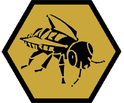 Saint Paul Natural Resources, in planning for 2016 and considering a couple important topics we have been working on, have self-declared 2016 to be the year of Birds and Bees!
Thus, in future issues, we will report progress on these topics including efforts to make Saint Paul a designated Audubon City USA, the efforts to expand upon last year’s opening of a Teaching Apiary in the Bruce Vento Nature Sanctuary--done in partnership with our friends, the University of Minnesota Bee Squad--and the ongoing work with the Saint Paul City Council to pass a Pollinator Protection Council Resolution. Our hope is that, by the end of January, the Saint Paul City Council will approve a resolution not only reducing or eliminating the use of harmful pesticides on public property, but also encouraging additional growth of a pollinator friendly flowers and vegetation, among other things. Stay tuned for updates in future issues regarding Birds and Bees (pollinators) accomplishments.
|
 From spring until fall, bees are on the hunt for nectar and pollen to sustain their colony. As they visit flower after flower, they perform an important role — the transfer of pollen, which fertilizes the plants so that they can produce seeds. Bees also promote genetic diversity by cross pollinating from different plants of the same species, which may help plant species better adapt to environmental pressures. Many people primarily think of bees as pollinators, but did you know that bats, beetles, butterflies, moths, and birds also pollinate flowers?
Bees are in decline due to a variety of factors. In an effort to support a healthy bee population, Saint Paul Natural Resources staff are choosing plant species that provide nectar and pollen throughout the growing season, avoid the use of pesticides that harm insects, and create suitable insect habitat.
One example is a project from this past fall. Youth from Urban Roots and the Conservation Corps Youth Outdoors program planted 865 native prairie flowers at Bruce Vento Nature Sanctuary. These plants were purchased with a Saint Paul Garden Club grant secured by Lower Phalen Creek Project with the goal of increasing the diversity of flowers for foraging bees.
|
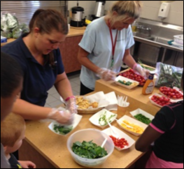 Child obesity and healthy eating habits have been on our consciousness for the past several years. The Natural Resources team decided to help connect kids with healthy eating options. Mark Granlund, Arts & Gardens Coordinator, connected with the Minnesota State Horticultural Society and arranged for most of the City’s recreation centers to receive one or more free Garden-In-A-Box kits so kids could plant, harvest and eat healthy vegetables grown right at the recreation center.
|
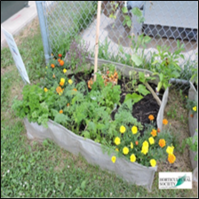 Garden-in-a-Box (GIAB) kits include garden boxes, soil, vegetable plants and instruction to help children and adults develop basic gardening skills as they learn to grow healthy food in small spaces.
Ron Finley, the guerilla gardener from south Los Angeles once said, “If a child grows a tomato, that child will eat a tomato”. This was our inspiration for connecting with the Garden-In-A-Box program and hundreds of youth across the City learned first-hand the benefits of urban gardens.
North Dale Recreation Center had a successful GIAB program in which 60 kids per day worked with staff to tend the garden, all while learning curriculum designed to educate them on the types of vegetables to grow in Minnesota, how to care for them upon harvest and different ways to prepare them to eat. The kids grew a variety of vegetables for easy preparation and consumption such as onions, basil, tomatoes, beets and kale.
|
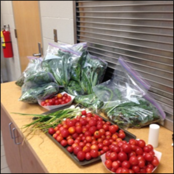 Of course the best part is when they created fun ways to eat their crop. Staff demonstrated how easy it is to make salads, salsa and smoothies and the kids had fun learning that healthy eating is available right in their own back yard.
At the end of the growing season the kids produced their own recipe cards and shared them with their families in an effort to bring their sustainability and healthy eating lessons home. North Dale staff enjoyed watching the kids participate and learn new skills. Plans are to continue the program in 2016.
Go to northerngardener.org for more information about the Garden-in-a-Box program.
|
Throughout the year, residents, visitors, and city officials nominate trees for the Landmark Tree Program that are of outstanding quality, historical value, or significance. The 2015 Landmark Tree Winners are… drum roll please… the Bur Oak at 609 Robert St S and the Sakura Cherry Trees in Como Park!
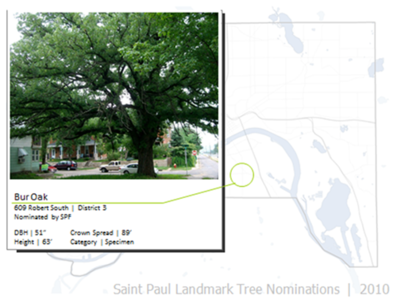
The Bur Oak on Robert St was chosen for its unique and impressive form. This tree spans 89 ft and was given the award for its large size and interesting branching structure.
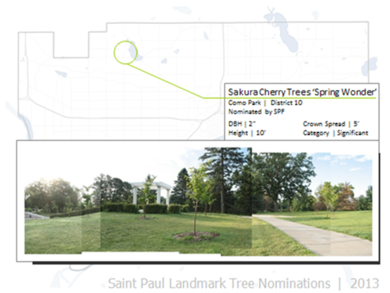 The Sakura Cherry Trees, donated by Nagasaki, Japan to Saint Paul in 2012, celebrate the anniversary of the original Japanese Cherry Tree donations to Washington DC 100 years ago. These trees received the Landmark Tree award because of the significance of this donation.
The Saint Paul - Nagasaki Sister City Committee hosts a celebration of the Sakura trees every June in Como Park. New trees are planted each year!
The Landmark Tree Winners will be officially recognized at the Blooming Saint Paul Awards ceremony in January.
If you are interested in nominating a tree to the Landmark Tree Program, please visit www.stpaul.gov/forestry and click on the Landmark Tree tab for the nomination form and other pertinent information. The Landmark Tree Program is sponsored by Bartlett Tree Experts.
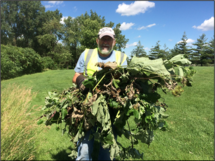 In 2015, an EcoStewards pilot program was begun at the Como Woodland Outdoor Classroom, located in Como Park. Nine EcoStewards volunteered 134.5 hours of time to maintain five parcels within the outdoor classroom: east oak savanna, west oak savanna, wet forest, short grass prairie, and tall grass prairie. Duties included invasive species removal, collecting seed and sowing seed. The EcoStewards did such a great job of helping maintain this area that Saint Paul Natural Resources is looking to expand this program to more volunteers in 2016.
If interested in helping contact Ryanna at: ryanna.jackson@ci.stpaul.mn.us.
|
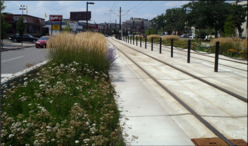 At the beginning of 2015, the Blooming Saint Paul program of Saint Paul Natural Resources was tasked with maintaining the 3.2 acres of planted medians along the Green Line light rail tracks on University Avenue. Staff had already been working for five years with MetroTransit and other city departments planning the plant palette, irrigation systems, and installation of the medians. Now it was finally time to take the medians from the contractors and begin maintaining them. We waited for the snow to melt and we discovered a bunch of happy healthy plants and a whole lot of litter. During this last summer we became familiar with the maintenance needs of this unique setting and how to work with Metro Transit in order to keep the plants healthy and weed and litter free. With a year under our belts, in 2016, we will start replanting areas that have had some difficulty and replace some plants that haven’t done well. The medians are a beautiful and colorful addition to an otherwise sterile and sometimes unattractive environment.
|
|